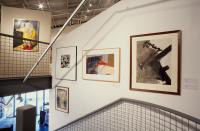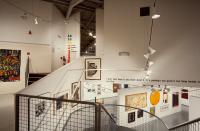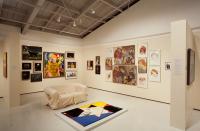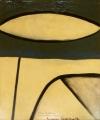Hit Parade: Contemporary Art from the Paris Family Collection
Wellington lawyer Les Paris and his wife Milly have amassed one of the largest collections of contemporary New Zealand art. Hit Paradefeatures 120 works from their collection. It’s a roll-call of big-name artists, including Rita Angus, Billy Apple, Colin McCahon, Philip Clairmont, Tony Fomison, Milan Mrkusich, Gordon Walters, and Toss Woollaston. The collection also includes younger artists, like Michael Parekowhai and Julian Dashper. Les says, ‘Some were bought from the artists when they were really unknown. We don't listen to the experts or to politics. There's a lot of politics in the art world.'
When Les and Milly married in 1963, they were given two art works as wedding presents. Soon after, they caught the art-collecting bug. At that stage, there are not many buyers of New Zealand art. Their first major acquisition is Peter McIntyre's portrait Maori Boy. In 1968, they buy their first abstract, Margot Philips's Waikato Hills. They also make their first visit to leading Auckland dealer, Barry Lett Galleries, resulting in their purchase of Don Binney's Kereru at Te Henga (1966). Les says, ’When we decided to specialise in contemporary art we got rid of the colonial, chocolate box, representational stuff. It didn't tie in with our current way of thinking.’ The Parises bought their first photograph—a Peter Peryer—in 1985. The collection also includes photos by Les Cleveland, Marie Shannon, and Fiona Pardington. In the 1980s, the couple raised their Strathmore weatherboard home and installed a gallery space underneath.
Hit Parade is the second time the Parises have exhibited their collection in a public gallery. The first was at the Dowse Art Museum in 1977, when Jim Barr was Director. However, two-thirds of the works on show at City Gallery have been acquired since then. In Metro magazine, City Gallery Director Paula Savage describes the Parises as, 'avid, instinctive and intelligent collectors whose interest in the visual arts is a consuming passion’.
The exhibition is divided in two. Curated by Greg Burke, downstairs focuses on abstract and formalist art from 1950s to 1990, with artists like Gordon Walters and Richard Killeen. However, Don Driver's striped roofing iron, Billy Apple's wine labels, and Michael Parekowhai's cuisinaire-rod sculpture complicate the distinctions between formalism and pop. On a central wall, the Parises also curate a selection of their favourites—including works by Ralph Hotere, Geoff Thornley, Don Driver, Peter Peryer, and Milan Mrkusich.
Upstairs, curated by Jim and Mary Barr, the focus is on figurative work. Works are salon hung, floor to ceiling, to convey the way they are experienced at the Parises’s home. Two key commissions are included. Don Binney painted Old Wellington Synagogue (1976) before it was demolished in 1977. It was where Les had his bar mitzvah and where the couple was married. There's also Toss Woollaston's portrait, The Paris Family (1977–85), and related studies.
When he first saw Woollaston's portrait, Les says, 'it was as though I'd been kicked in the guts. But the more I looked at it the more I thought it was us. Prominently placed in the painting, Milly says, ‘He'd painted it as he'd seen us. I was quite surprised because I had always thought of Les as having the most important part. But when I looked at it, I thought no, he's given me the central part there and it just got me thinking that yes, that's what a mother does do—she holds everything together.'
In the Dominion, Jane Sayle writes, 'Hit Parade is a pure expression of the myth of the collector, right down to a mock-up of the living room of the collectors … In this big, important, and mostly male art, the viewer is so empowered that apparently, junior collectors have been scurrying to the dealers and auction houses for a Mrkusich or a Walters.'
The public programme includes the panel discussion ‘Would You Have Any Trouble Spending $100,000 on Art?’, chaired by curator Jim Barr, with Dominion TV critic Raybon Kan, actress Miranda Harcourt, and historian Judith Fyfe. However, Les tells the media that collecting is not all about money: ‘You don't need a fortune—you get it by organising your priorities, instead of overseas trips you go to Rotorua, and you drive an old Ford.’ Meanwhile, Milly speaks to the Evening Post of the loss she experienced when the works were taken away for the show. 'When I saw the empty space and the yellow tags where they'd been, it gave me a horrible feeling.'
The Gallery extends Hit Parade by a week at the request of the New Zealand Law Society, so delegates at the 1993 Law Conference can see it. Hit Parade is the last exhibition at Chews Lane, before the Gallery relocates to the refurbished Library in Civic Square.
In 2000, Les Paris dies, aged 72. In 2012, when Milly moves to Sydney to be closer to her son, the first auction of the Paris art collection is held. Milly tells the Herald, 'When a work of art hit us, we did not need to discuss its purchase at any length, for we both knew instinctively and simultaneously that, if it was at all viable, we would like to live with it in our home forever and ever. At that time, no such thought ever entered our heads that the day may come when one of us would have to downsize the collection and move to another country.' A second auction is held in 2018. The combined Art + Object auctions bring in $6.52 million.
Text extracted from the City Gallery Wellington Te Whare Toi website.
A publication of this work can be found on the City Gallery Wellington Te Whare Toi website.










